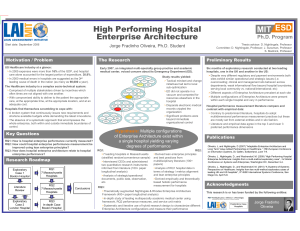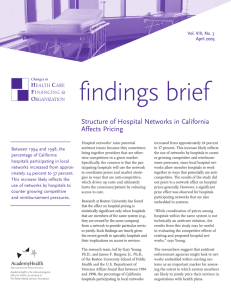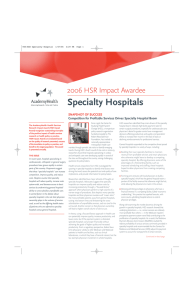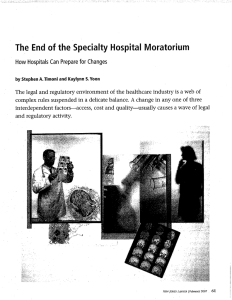ESS MIT ESD High Performing Hospital
advertisement
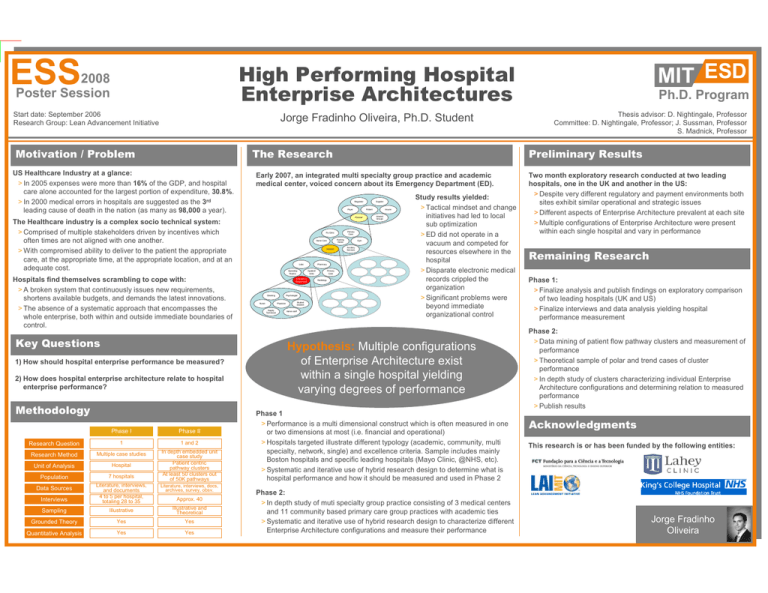
ESS High Performing Hospital Enterprise Architectures 2008 Poster Session Start date: September 2006 Research Group: Lean Advancement Initiative Jorge Fradinho Oliveira, Ph.D. Student Motivation / Problem Early 2007, an integrated multi specialty group practice and academic medical center, voiced concern about its Emergency Department (ED). Regulator Payer Hospitals find themselves scrambling to cope with: > A broken system that continuously issues new requirements, shortens available budgets, and demands the latest innovations. > The absence of a systematic approach that encompasses the whole enterprise, both within and outside immediate boundaries of control. Key Questions 1) How should hospital enterprise performance be measured? 2) How does hospital enterprise architecture relate to hospital enterprise performance? Methodology Phase I Phase II Research Question 1 1 and 2 Research Method Multiple case studies In depth embedded unit case study Patient centric pathway clusters At least 50 clusters out of 50K pathways Unit of Analysis Hospital Population 7 hospitals Data Sources Interviews Literature, interviews, and documents 4 to 5 per hospital, totaling 28 to 35 Sampling Illustrative Illustrative and Theoretical Grounded Theory Yes Yes Quantitative Analysis Yes Yes Literature, interviews, docs, archives, survey, obsv. Approx. 40 Primary Care Flu Clinic Nursing Home Home Care Hospital Labs Operating Rooms Emergency Department Cleaning Nurse Psychologist Physician Supply Technician Student resident Admin staff Pharmacy Inpatient Units Primary Care Radiology Gym Ancillary Services Supplier Patient Provider The Healthcare industry is a complex socio technical system: > Comprised of multiple stakeholders driven by incentives which often times are not aligned with one another. > With compromised ability to deliver to the patient the appropriate care, at the appropriate time, at the appropriate location, and at an adequate cost. Ph.D. Program Thesis advisor: D. Nightingale, Professor Committee: D. Nightingale, Professor; J. Sussman, Professor S. Madnick, Professor Preliminary Results The Research US Healthcare Industry at a glance: > In 2005 expenses were more than 16% of the GDP, and hospital care alone accounted for the largest portion of expenditure, 30.8%. > In 2000 medical errors in hospitals are suggested as the 3rd leading cause of death in the nation (as many as 98,000 a year). MIT ESD Insurer Interest Groups Study results yielded: > Tactical mindset and change initiatives had led to local sub optimization > ED did not operate in a vacuum and competed for resources elsewhere in the hospital > Disparate electronic medical records crippled the organization > Significant problems were beyond immediate organizational control Hypothesis: Multiple configurations of Enterprise Architecture exist within a single hospital yielding varying degrees of performance Phase 1 > Performance is a multi dimensional construct which is often measured in one or two dimensions at most (i.e. financial and operational) > Hospitals targeted illustrate different typology (academic, community, multi specialty, network, single) and excellence criteria. Sample includes mainly Boston hospitals and specific leading hospitals (Mayo Clinic, @NHS, etc). > Systematic and iterative use of hybrid research design to determine what is hospital performance and how it should be measured and used in Phase 2 Phase 2: > In depth study of muti specialty group practice consisting of 3 medical centers and 11 community based primary care group practices with academic ties > Systematic and iterative use of hybrid research design to characterize different Enterprise Architecture configurations and measure their performance Two month exploratory research conducted at two leading hospitals, one in the UK and another in the US: > Despite very different regulatory and payment environments both sites exhibit similar operational and strategic issues > Different aspects of Enterprise Architecture prevalent at each site > Multiple configurations of Enterprise Architecture were present within each single hospital and vary in performance Remaining Research Phase 1: > Finalize analysis and publish findings on exploratory comparison of two leading hospitals (UK and US) > Finalize interviews and data analysis yielding hospital performance measurement Phase 2: > Data mining of patient flow pathway clusters and measurement of performance > Theoretical sample of polar and trend cases of cluster performance > In depth study of clusters characterizing individual Enterprise Architecture configurations and determining relation to measured performance > Publish results Acknowledgments This research is or has been funded by the following entities: Jorge Fradinho Oliveira





